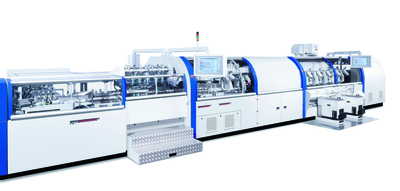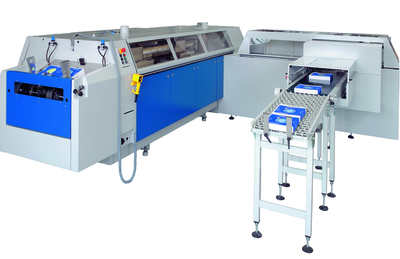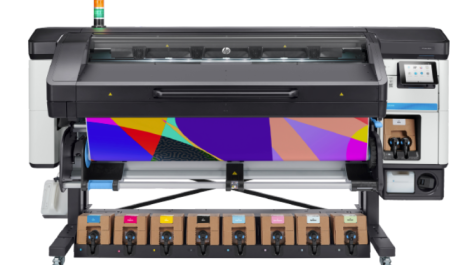Wohlenberg Quickmax perfect binder
Perfect binding, thread sewing and case binding all have their place in the book market. How are these processes being developed to cater for increasing demands for print runs as short as one copy?
The paperback book run length of one is already very familiar, thanks partly to online ordering services such as Amazon that have turned publishing models on their heads, while in the UK photobooks remains a market with much potential. Digital printing is of course the facilitator for the on demand book market, and book finishing has had to fall in line.
Across the board, book print runs are reducing to take advantage of the economics of these publishing models, and technology developers are striving to keep pace with the needs of printers and trade finishers serving the book market. Greater automation has in many cases reduced the once onerous make ready process to simply the pushing of a few buttons – sometimes less than that in fact, given bar code reading capabilities and data networking that make it possible for the second book to be a different size and format to the one that preceded it.
However, there are several different ways to finish a book, beyond simply whether the cover is soft or hard, and while the general direction of advance (the one copy run length) is the same for these processes, the rate of advance towards those goals in perfect binding, thread sewing and casemaking/casing in is not necessarily uniform. Here we speak to the manufacturers and distributors at the heart of these developments.
Perfect binding
Much of the focus in perfect binding of late has been around PUR glue, but it still accounts only for a minority of the perfect bound work seen in the market, according to Alan Harrison of Intelligent Finishing Systems.
‘It’s in certain types of market that customers require PUR, maybe because of the higher quality bind, longer shelf life, or working with difficult stocks, but the majority of perfect bound books in the UK will still be EVA. We have got some systems that do EVA and PUR together, or some that only do one. We are seeing increasing requests for PUR binders though; people like the strength that the glue brings.’
The company sells the Horizon perfect binding systems from Japan, the latest of which is the BQ-280 PUR, which is effectively a beefed up version of the BQ- 270 EVA model but with a PUR tank put in. These single clamp systems are effective for runs of one to 1000 copies.
In the digital market, where run lengths are short and sometimes consist of variable formats and thicknesses of books, automation is the key to success. ‘That’s what we sell on,’ Mr Harrison continued. ‘It’s Horizon’s vision of how all their systems work: automatic operation on the screen; tool-less.’
The same can be said for systems such as Morgana’s DigiBook binders, and the Wohlenberg perfect binders sold by Friedheim International. ‘The ongoing trend is of increased automation in perfect binding,’ confirmed Friedheim’s Roger Cartwright. ‘We are using more what we call dynamic drive technology now, rather than gear boxes and shafts, and that gives you significantly more control over the process. You can control each part uniquely and that’s having a major impact.’
He added that customers are looking for machines that can match a cover to a book block, which is possible on certain machines. ‘On the smaller Wohlenberg Quickmax you can produce customisable book sizes. It can mechanically take book blocks of different sizes consecutively, and that’s a major step forward for a machine of this type. The flexibility it allows for digital production is really quite fantastic.’
Kolbus watched the developing digital and short run market for some time before actively getting involved. It was time well spent, according to Greg Bird of Kolbus UK. ‘By sitting back we learned an awful lot. One of the biggest learnings was how you present the book block – there were systems where loose sheets were glued from the back of a printing press and then pushed into a binder. We were never sold on that. Having a folded section is always better than loose sheets and you can do it at higher speed. We came up with a solution for all outputs, digitally and conventionally-printed sheets on the same binder.
‘We decreased the make ready of the binding system to an absolute minimum to cope with short run products, and once we had done that we came up with something that accepts variable input. That’s where we are in our binding lines. The KM200 was launched at drupa and is a zero make ready machine. It changes jobs without stopping but it can also run at 5000 per hour so youcan do a conventional job.’
Müller Martini has also got involved in short run production, and says that all of its perfect binding lines are ‘digital ready’. ‘One to a couple of hundred books is the norm now,’ said the company’s David McGinlay. ‘That’s why we aim for quick or zero make ready every time, first book usable, no waste.
We make ready from a measuring device called the Book Data Centre which gives us absolutely accurate figures that go into the machine for set up. Customers now know that a book is 9.7 mm thick, rather than estimating at 10 mm – that’s how you guarantee the first book is saleable.’

Kolbus KM 200 perfect binder
Thread sewing
Thread sewing is enjoying something of a resurgence in the UK, which is good news for companies such as Kolbus UK, which is the UK agent for Italian manufacturer Meccanotecnica, and Perfect Bindery Solutions with its similarly Italian-manufactured Smyth systems.
‘With the advent of PUR, the sewn book has become less in demand in recent times, but a lot of people are realising that it’s quite a convenient way of doing short run work and it will always give you a higher quality book,’ said Greg Bird of Kolbus.
The Universe sewer from Meccanotecnica takes flat sheets from a digital press, folds, collates and then sews them into a book block. ‘They have developed the machinery to fit into the digital market,’ he continued. ‘It is very niche but there’s a machine in the UK doing that (at Halstan, Amersham), and giving a very high quality book in runs of less than five. It can also run at normal speeds of 160 sections per minute.’ More on the Smyth thread sewing systems can be found on pages 47 to 49.
Casemaking/casing in
Have we reached the stage where case bound books in runs of one are feasible? Almost, according to Greg Bird of Kolbus UK. He said: ‘Certainly below 10 is quite common.
We have put casemakers into photo labs that are making photobooks, though admittedly their sizes are quite standard, but they are doing runs of one. Gone are the days when the first 10 cases were going in the bin. Pretty much the first product out is a usable product.
‘What we have learned is that, with all our machines, make ready time is now the most essential criteria. In certain markets running speeds are not important any more – if you’re doing a run of 10 the speed is irrelevant.’
David McGinlay of Müller Martini also speaks of a ‘first book saleable’ ethos. He added: ‘The Diamant MC Digital is a photobook system, fully automated, one book behind the other, sequential make ready, which we can only do because it is servo and bar code driven, and that technology has been taken to the standard book lines as well. With the Diamant MC60 you have a machine that can do one book to one million books.’
Such systems have been the binding line of choice for the large book manufacturers, but Kolbus installed a highly sophisticated case binding line at Harrier LLC, which is more of a photo products manufacturer, last year. The DA260 casemaker and BF512 casing- in machine delivers 30 cased in books per minute. The Kolbus line gives Harrier huge capacity to take on trade case book production.
Speaking to Digital Printer last year, James Belton, Harrier’s operational planning and solutions manager, said: ‘It is phenomenal compared to the previous manual case maker. This takes one person to load it and one person to unload. And it can do ten times the volume of the manual casemaking line as well. We can make cases for pennies whereas before it was pounds. The direction of the market in books is towards smaller runs and we made an investment based on that.’
Few printing companies can afford such technology but there are options, one of which is the Tecnograf casemaking equipment sold by Friedheim International. Roger Cartwright of Friedheim explained that production- wise Tecnograf ‘falls in between the bigger machines from Kolbus and Müller Martini, and the single pedestal type machines’, adding: ‘We can offer a good level of automation for those companies that don’t necessarily have the capacity that the Kolbus requires. With one-off production the interest in free standing machines is also quite healthy really.
‘For years it was the big guys selling the big machines or the very basic single level machines, and the big development is that there is something between the two now.





